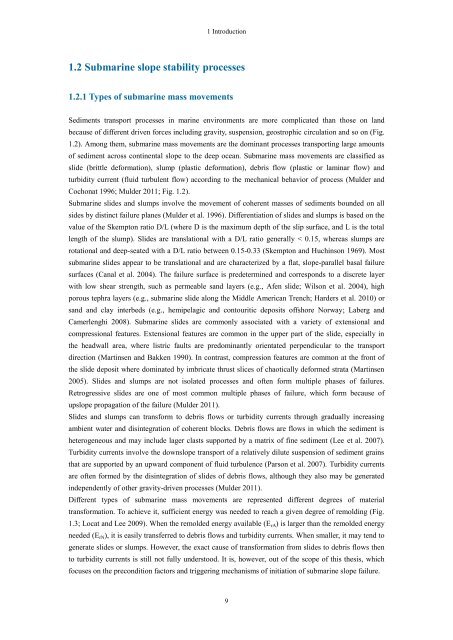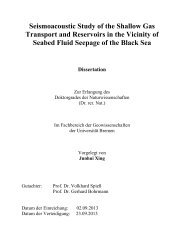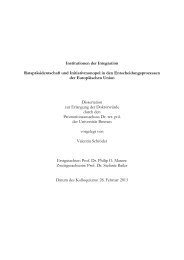Slope stability along active and passive continental margins ... - E-LIB
Slope stability along active and passive continental margins ... - E-LIB
Slope stability along active and passive continental margins ... - E-LIB
You also want an ePaper? Increase the reach of your titles
YUMPU automatically turns print PDFs into web optimized ePapers that Google loves.
1 Introduction<br />
1.2 Submarine slope <strong>stability</strong> processes<br />
1.2.1 Types of submarine mass movements<br />
Sediments transport processes in marine environments are more complicated than those on l<strong>and</strong><br />
because of different driven forces including gravity, suspension, geostrophic circulation <strong>and</strong> so on (Fig.<br />
1.2). Among them, submarine mass movements are the dominant processes transporting large amounts<br />
of sediment across <strong>continental</strong> slope to the deep ocean. Submarine mass movements are classified as<br />
slide (brittle deformation), slump (plastic deformation), debris flow (plastic or laminar flow) <strong>and</strong><br />
turbidity current (fluid turbulent flow) according to the mechanical behavior of process (Mulder <strong>and</strong><br />
Cochonat 1996; Mulder 2011; Fig. 1.2).<br />
Submarine slides <strong>and</strong> slumps involve the movement of coherent masses of sediments bounded on all<br />
sides by distinct failure planes (Mulder et al. 1996). Differentiation of slides <strong>and</strong> slumps is based on the<br />
value of the Skempton ratio D/L (where D is the maximum depth of the slip surface, <strong>and</strong> L is the total<br />
length of the slump). Slides are translational with a D/L ratio generally < 0.15, whereas slumps are<br />
rotational <strong>and</strong> deep-seated with a D/L ratio between 0.15-0.33 (Skempton <strong>and</strong> Huchinson 1969). Most<br />
submarine slides appear to be translational <strong>and</strong> are characterized by a flat, slope-parallel basal failure<br />
surfaces (Canal et al. 2004). The failure surface is predetermined <strong>and</strong> corresponds to a discrete layer<br />
with low shear strength, such as permeable s<strong>and</strong> layers (e.g., Afen slide; Wilson et al. 2004), high<br />
porous tephra layers (e.g., submarine slide <strong>along</strong> the Middle American Trench; Harders et al. 2010) or<br />
s<strong>and</strong> <strong>and</strong> clay interbeds (e.g., hemipelagic <strong>and</strong> contouritic deposits offshore Norway; Laberg <strong>and</strong><br />
Camerlenghi 2008). Submarine slides are commonly associated with a variety of extensional <strong>and</strong><br />
compressional features. Extensional features are common in the upper part of the slide, especially in<br />
the headwall area, where listric faults are predominantly orientated perpendicular to the transport<br />
direction (Martinsen <strong>and</strong> Bakken 1990). In contrast, compression features are common at the front of<br />
the slide deposit where dominated by imbricate thrust slices of chaotically deformed strata (Martinsen<br />
2005). Slides <strong>and</strong> slumps are not isolated processes <strong>and</strong> often form multiple phases of failures.<br />
Retrogressive slides are one of most common multiple phases of failure, which form because of<br />
upslope propagation of the failure (Mulder 2011).<br />
Slides <strong>and</strong> slumps can transform to debris flows or turbidity currents through gradually increasing<br />
ambient water <strong>and</strong> disintegration of coherent blocks. Debris flows are flows in which the sediment is<br />
heterogeneous <strong>and</strong> may include lager clasts supported by a matrix of fine sediment (Lee et al. 2007).<br />
Turbidity currents involve the downslope transport of a relatively dilute suspension of sediment grains<br />
that are supported by an upward component of fluid turbulence (Parson et al. 2007). Turbidity currents<br />
are often formed by the disintegration of slides of debris flows, although they also may be generated<br />
independently of other gravity-driven processes (Mulder 2011).<br />
Different types of submarine mass movements are represented different degrees of material<br />
transformation. To achieve it, sufficient energy was needed to reach a given degree of remolding (Fig.<br />
1.3; Locat <strong>and</strong> Lee 2009). When the remolded energy available (E rA ) is larger than the remolded energy<br />
needed (E rN ), it is easily transferred to debris flows <strong>and</strong> turbidity currents. When smaller, it may tend to<br />
generate slides or slumps. However, the exact cause of transformation from slides to debris flows then<br />
to turbidity currents is still not fully understood. It is, however, out of the scope of this thesis, which<br />
focuses on the precondition factors <strong>and</strong> triggering mechanisms of initiation of submarine slope failure.<br />
9
















